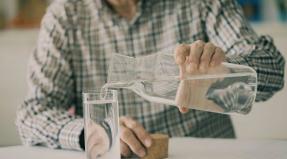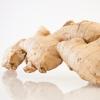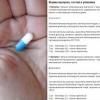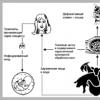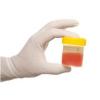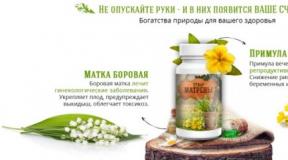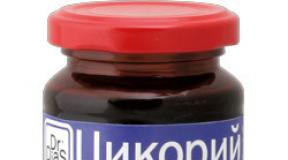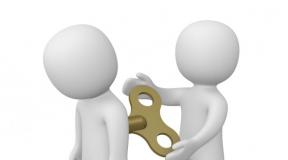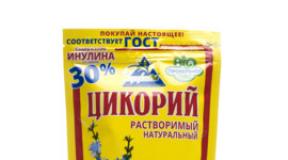Perform artificial respiration from mouth to mouth. Correct performance of artificial lung ventilation. Features of resuscitation in children
Artificial respiration from mouth to nose is performed if the patient's teeth are clenched or there is an injury to the lips or jaws. The rescuer, placing one hand on the forehead of the victim, and the other on his chin, hyperextends his head and at the same time presses him lower jaw to the top
With the fingers of the hand supporting the chin, he should press the lower lip, thereby sealing the mouth of the victim. After a deep breath, the rescuer covers the victim's nose with his lips, creating the same air-tight dome above him. Then the rescuer makes a strong blowing of air through the nostrils (1-1.5 l), while watching the movement chest.
After the end of artificial inhalation, it is necessary to release not only the nose, but also the patient's mouth, the soft palate can prevent air from escaping through the nose, and then there will be no exhalation at all when the mouth is closed! It is necessary with such an exhalation to keep the head overbent (i.e., thrown back), otherwise the sunken tongue will interfere with exhalation. The duration of the exhalation is about 2 s. In a pause, the rescuer takes 1-2 small breaths - exhalations “for himself”.
Artificial respiration should be carried out without interruption for more than 3-4 seconds, until full spontaneous breathing is restored or until a doctor appears and gives other instructions. It is necessary to continuously check the effectiveness of artificial respiration (good inflation of the patient's chest, absence of bloating, gradual pinking of the skin of the face). Constantly make sure that vomit does not appear in the mouth and nasopharynx, and if this happens, before the next breath, a finger wrapped in a cloth should be cleared through the mouth of the victim's airways. As artificial respiration is carried out, the rescuer may feel dizzy due to a lack of carbon dioxide in his body. Therefore, it is better that two rescuers carry out air injection, changing after 2-3 minutes. If this is not possible, then every 2-3 minutes the breaths should be reduced to 4-5 per minute, so that during this period the level of carbon dioxide.
When carrying out artificial respiration in a victim with respiratory arrest, it is necessary to check every minute whether he also had a cardiac arrest. To do this, periodically feel the pulse with two fingers on the neck in the triangle between the windpipe (laryngeal cartilage, which is sometimes called the Adam's apple) and the sternocleidomastoid (sternocleidomastoid) muscle. The rescuer places two fingers on the lateral surface of the laryngeal cartilage, after which he “slips” them into the hollow between the cartilage and the sternocleidomastoid muscle. It is in the depths of this triangle that the carotid artery should pulsate.
If there is no pulsation on the carotid artery, an indirect heart massage should be started immediately, combining it with artificial respiration.
If you skip the moment of cardiac arrest and perform only artificial respiration without heart massage for 1-2 minutes, then, as a rule, it will not be possible to save the victim.
Everyone should know how to do artificial respiration correctly. To achieve oxygen supply to the brain, first aid is provided: artificial ventilation of the lungs and cardiac massage. Basic Rule emergency care: it is better to perform resuscitation incorrectly, to use alternative types of artificial respiration, than to completely abandon it.
Everyone should know how to do artificial respiration correctly.
Methods and basic rules of ventilation
Before performing resuscitation, you need to call emergency assistance and try to find nearby people who will participate in rescuing the victim. It is also required to provide safe conditions for resuscitation.
Algorithm for performing artificial respiration:

Before proceeding with artificial respiration, it is necessary to clear the airways
- Free up the airways. It is forbidden to breathe if they are damaged, if there is a foreign object in them. In such cases, the air will not go into the lungs, but into the stomach. If water has accumulated in the pathways, then it can be removed: bend the person face down over the thigh of the bent leg, squeeze the chest from the sides with sharp jerks.
- Kneel on the right side of the victim.
- Tilt the head of the victim, bring the lower jaw forward. To fix the jaw, you can insert a rolled bandage into your mouth.
- Pinch the person's nose.
- Breathe in the air. The depth of inspiration should be maximum.
- Press your lips tightly against the victim's mouth, trying to ensure tightness.
- Make an exhale. Assess whether the chest is moving at this moment.
- If it is impossible to open the mouth and open the jaw, the air is blown into the nose. The lips must be closed.
- If the chest does not rise, then the person's head should be thrown back even more and repeated blowing.
- If the chest moves, then you need to make 2 such exhalations, then immediately proceed to an indirect heart massage.
- Resuscitation is continued until the person begins to breathe on his own or until help arrives.
Artificial respiration techniques:
- Breathing mouth to mouth.
- Breathing mouth to nose with spasm of masticatory muscles.
- For small children, IVL is carried out both in the mouth and in the nose at the same time.
In cases where artificial ventilation of the lungs is not possible, immediately proceed to an indirect heart massage.
When to start resuscitation

Before starting resuscitation, the person is turned on his back and the airway is opened.
It is important to understand in what cases artificial respiration is performed in case of suspected clinical death:
- The person is turned onto their back on a hard surface and the airway is opened.
- The head is gently thrown back.
- The clothes are unbuttoned to see the chest.
- Assess the state of breathing. If it is not audible, the sternum does not rise, urgently begin resuscitation. It is important not to confuse breathing with occasional agonal sighs. 10 seconds are given for evaluation, then mechanical ventilation is required.
- Based on the situation, choose the method of artificial respiration.
The most common ventilation method- artificial respiration from mouth to mouth. It allows a person who does not have a special medical education, render needed help in a critical situation.

It is important to tightly cover the other person's lips with yours so that air enters the respiratory tract.
Rules for holding artificial ventilation lung mouth to mouth:
- If possible, the mouth is covered with gauze or a light handkerchief that allows air to pass through to comply with safety and hygiene measures.
- The oral cavity is cleaned of foreign bodies with a cloth wound around a finger.
- You can try to open the clenched jaw with the handle of a spoon or other flat object.
- It is important to tightly cover the other person's lips with yours so that air enters the respiratory tract.
- The exhalation lasts 1.5-2 seconds and should be deep.
- After blowing, it is necessary to step back, allowing air to escape.
- The frequency of air injections per minute during artificial respiration is 12-15 times, 4-5 seconds are spent on each cycle.
Artificial respiration from mouth to nose
If the victim's jaws do not open, then the question may arise how to do artificial ventilation of the lungs. In this case, resuscitation is carried out using the mouth-to-nose method, the procedure for conducting artificial respiration changes. From a physiological point of view, this technique of artificial respiration is preferable, since the victim inhales atmospheric air with a large amount of oxygen, while the air blown into the nose contains more carbon dioxide.
Algorithm for artificial respiration in the nose:

- Tilt the person's head back.
- Free up the airways.
- Cover your nose with a damp cloth.
- Cover your mouth with your palm.
- Take a breath.
- Exhale air into the victim's nose.
- Pull back, watching the movement of the chest.
- The exhalation of the victim occurs passively.
Ventilation methods are chosen based on the situation, breathing into the nose is done only if it is not possible to open the victim's mouth. At the same time, you should not waste time trying to open your jaws, but immediately start artificial respiration.
How to perform artificial respiration with closed heart massage
If the victim has no breathing and no pulse, then resuscitation includes indirect indoor massage hearts. You need to know what actions are performed during artificial respiration in conjunction with a massage of the heart muscle, so as not to harm a person. Indeed, in case of an error, the blown air will not enter the lungs.
Technique for artificial lung ventilation with closed heart massage:

- Lay the victim down on a hard, hard surface.
- Release the chest from clothing.
- Perform IVL in an accessible way.
- Then proceed to an indirect heart massage.
- The palms are placed on the center of the sternum, the fingers are interlaced. It is important not to touch the ribs with the brushes, otherwise there is a risk of fracture.
- They bend over the patient so that the arms rise perpendicularly above his sternum.
- Using body weight, the rescuer bends the victim's chest down by 5-6 cm, then waits for its full recovery.
- The frequency of compressions is 100-120 per minute.
- It is important to keep the ratio of 30:2. After 2 breaths, 30 chest compressions are performed.
- Cardiopulmonary resuscitation is carried out until consciousness is restored.
IVL and closed massage of the heart muscle are allowed to be carried out separately from each other.
Cardiopulmonary resuscitation is a difficult process, so it is better to perform it with assistants.
How to perform CPR on young children
CPR is more difficult for young children because of the high risk of rib fractures. If the child does not show signs of life, then it is unacceptable to postpone the ventilator. Artificial respiration to the child is performed simultaneously in the mouth and nose, covering them with their lips. Pressure is applied to the sternum with fingers or one hand.
Resuscitation technique for children:

IVL technique for young children
- Organize airway patency, open the chest.
- Remove foreign objects from the oral cavity.
- Execute ID. If it is not possible to cover the nose and mouth at the same time, then mechanical ventilation is carried out in an accessible way. Blowing air into the respiratory tract of a small child takes 1-1.5 seconds.
- It is necessary to make 5 breaths, after each they are removed to control the movement of the chest.
- If the sternum does not rise, carry out 5 more exhalations.
- If after that the chest does not move, this is a sign that the child has a foreign object in the airways. You have to try to get it out. To do this, make 5 sharp blows with the palm between the shoulder blades in the direction from the back to the head. Then the mouth is again examined for the presence foreign body.
- If the sternum moves, then begin to massage the heart muscle. It is performed by pressing on the center of the chest.
- Children under one year old are pressed on the chest with their fingers, older than a year old - with their hands.
- The depth of pressure is a third of the thickness of the chest, it is important not to overdo it and not press too hard. The intervals between clicks are minimal.
- You need to press often, up to 100 compressions per minute. After 30 pressures, mechanical ventilation is repeated, 2 breaths are taken. Repeat as many times as necessary to restore consciousness.
- While waiting for the doctors, you can not leave the child alone, you need to keep him warm, in the position on his side.
- Be prepared to resume CPR at any time.
Providing first aid to a child is the responsibility of an adult.
Typical mistakes during ventilation
An untrained person can perform CPR with errors that will exacerbate the problem:
- Delaying resuscitation. In a difficult situation, you can’t hesitate, the rescuer has a maximum of 8 minutes before the patient’s vital systems stop working.
- Incorrect IVL sequence. First, the airways are cleared, oral cavity, only then carry out ventilation of the lungs.
- Loose pressing of the lips to the lips of the victim, lack of tightness. This results in less air getting into the lungs.
- Extra time is spent trying to open the patient's jaw. If the mouth cannot be opened, then mouth-to-nose resuscitation begins.
- Long pauses between breaths and insufficient volume of air blown. Breaks are made for the purpose of short-term rest, it is necessary to work at a fast pace. Optimal ventilation during artificial respiration lasts 1.5-2 seconds at a frequency of 120 times per minute.
- The rescuer does not check the correctness of artificial respiration, does not control the movement of the sternum.
- The person providing assistance does not stop artificial respiration and at the same time begins a closed massage. Insufflations in this case do not make sense, since oxygen will not enter the blood.
It is impossible to be as prepared as possible for a difficult situation, but each person must be able to perform resuscitation in order to help the victim survive until the arrival of professionals.
The rescuer should stand on the side of the victim's head (preferably on the left). If the victim lies on the floor, then you have to kneel. It is necessary to quickly clear the mouth and throat of the victim from vomit.
If the jaws of the victim are tightly compressed, then they must be moved apart.
Then, putting one hand on the forehead of the victim, and the other on the back of the head, they re-bend (that is, recline back) the head of the victim, while the mouth, as a rule, opens.
They take a deep breath, press their lips tightly against the mouth of the victim and exhale vigorously, then the person assisting removes his lips from the mouth of the victim and takes his head to the side.
In this case, the nostrils of the victim must be closed with the thumb and forefinger of the hand lying on his forehead.
Lack of tightness is a common mistake in artificial respiration.
In this case, air leakage through the nose or corners of the mouth of the victim nullifies all the efforts of the rescuer. After sealing, the rescuer makes a quick, strong exhalation, blowing air into the airways and lungs of the victim.
Rice. Carrying out artificial respiration.
The exhalation of the rescuer should last about 1 s and reach 1.0-1.5 liters in volume in order to cause sufficient stimulation of the respiratory center.
The exhalation of the victim should last about 2 s, in any case it is better that it be twice as long as the inhalation.
In a pause before the next breath, the rescuer needs to take 1-2 small ordinary breaths “for himself”. After the end of the exhalation, the rescuer unbends and releases the victim's mouth, in no case stopping the overextension of his head, otherwise the tongue will sink and there will be no full-fledged independent exhalation.
In this case, it is necessary to continuously monitor whether the chest of the victim rises well during artificial inspiration.
If the amplitude of such respiratory movements is insufficient, then the volume of air blown in is small or the tongue sinks.
Effective artificial respiration, carried out in combination with chest compressions, requires a rhythmic repetition of vigorous breaths at a frequency of 12-15 per 1 min, i.e. one "breath" for 4-5 chest compressions.
These manipulations should be alternated so that the blowing does not coincide with the moment of chest compression during heart massage. In cases of preserved independent work of the heart, the frequency of artificial breaths should be increased to 20-25 per 1 min.
Artificial respiration by mouth-to-nose method
Artificial respiration using the mouth-to-nose method is performed if the victim has clenched teeth or has an injury to the lips or jaws.
The rescuer, putting one hand on the forehead of the victim, and the other on his chin, hyperextends his head and at the same time presses his lower jaw to the upper one. With the fingers of the hand supporting the chin, he should press the upper lip, thereby sealing the mouth of the victim.
After a deep breath, the rescuer covers the victim's nose with his lips. Then the rescuer makes a strong blowing of air through the nostrils (1.0-1.5 l), while watching the movement of the victim's chest.
precordial beat
When sudden death especially after defeat electric shock, the first thing you need to start helping is to strike at the victim's sternum.
The meaning of such a blow is to shake the chest as much as possible, and this can be the impetus for the "start" of the stopped heart. Often such a blow to the sternum restores the heartbeat and returns the consciousness of a person. Simple but very effective way. If the blow is delivered within the first minute after cardiac arrest, then the probability of revival exceeds 50%.
A precordial blow is applied with a fist to a point located on the lower middle third of the sternum 2-3 cm above the xiphoid process.
To perform it, after making sure that there is no pulse on the carotid artery, it is necessary to cover the xiphoid process with two fingers and strike the sternum with a fist slightly above your fingers.
The blow should be short and sharp enough.
Immediately after the stroke, it is necessary to find out if the work of the heart has resumed? Why, after the impact, be sure to check the pulse on the carotid artery. If a pulse appears, begin artificial ventilation of the lungs.
If the heart did not work and the restoration of natural blood circulation did not occur, then they proceed to an indirect heart massage.
When striking if there is a pulse on the carotid artery, there is a risk of provoking cardiac arrest. Therefore, the determination of the absence of a pulse on the carotid artery before applying a precordial stroke is a mandatory requirement.
Do not apply a precordial blow to the xiphoid process of the sternum, as this can lead to liver injury.
Heart massage
Heart massage- mechanical impact on the heart after it has stopped in order to restore activity and maintain continuous blood flow until the heart resumes its work. Indications for heart massage are all cases of cardiac arrest.
There are two main types of heart massage: indirect, or external (closed), and direct, or internal (open).
Indirect (closed) massage heart is based on the fact that when you press the chest from front to back, the heart, located between the sternum and spine, is compressed so much that blood from its cavities enters the vessels. After the cessation of pressure, the heart expands and venous blood enters its cavity.
Direct (open) massage heart consists in its periodic squeezing by a hand inserted into the chest cavity. This type of massage is used only by the surgeon in case of cardiac arrest during surgery on the organs of the chest cavity.
Lay the victim on his back, unfasten clothing that restricts breathing, put a roller of clothing under the shoulder blades;
Ensure airway patency, which may be blocked by a sunken tongue or homogeneous contents. To do this, tilt the head of the victim as much as possible, placing one hand under the neck and pressing the other on the forehead. In this position, the mouth usually opens, and the tongue moves to the back of the larynx, providing airway patency;
If there is foreign matter in the mouth, turn the victim's shoulders and head to the side and clean the mouth and throat with a bandage, handkerchief or shirt edge wound around the index finger;
If the mouth does not open, then carefully insert a metal plate, plank, etc. between the back teeth, open the mouth and, if necessary, clean the mouth and throat;
After that, kneel down on either side of the victim’s head and, holding the head tilted back, take a deep breath and, pressing your mouth tightly (through a handkerchief or gauze) to open mouth the victim, strongly blow air into him;
At the same time, close the nose of the victim with the cheek or finger of the hand on the forehead;
See to it that the air enters the lungs and not the stomach, this is revealed by the bloating of the abdomen and the absence of expansion of the chest. If air has entered the stomach, remove it from there by quickly pressing for a short time the area of \u200b\u200bthe stomach between the sternum and the navel;
Take measures to free the airways and repeat blowing air into the lungs of the victim;
After blowing in, the mouth and nose of the victim should be released for the free exit of air from the lungs. For a deeper exhalation, slightly press on the chest;
Each air injection should be made after 5 seconds, which corresponds to the rhythm of one's own breathing;
If the jaws of the victim are compressed so tightly that it is not possible to open the mouth, then breathe according to the mouth-to-nose method, i.e. blow air into the nose of the victim;
When the first independent breaths appear, artificial respiration should be timed to coincide with the beginning of an independent breath;
Perform artificial respiration until deep and rhythmic breathing is restored in the victim.
4.8. External cardiac massage performed in case of cardiac arrest, which is determined by the absence of a pulse, dilated pupils and cyanosis of the skin and mucous membranes:
Lay the victim on his back on a hard surface or put a board under him, free his chest from clothes and raise his legs by about 0.5 m;
Position yourself on the side of the victim and determine the place of pressure, to do this, feel for the lower soft end of the sternum and determine the point of pressure 3-4 cm above this place along it;
Put the palm on the place of pressure so that the fingers do not touch the chest, put the palm of the second hand at a right angle on the back of the palm of the first hand;
Make a quick (push) and strong pressure on the sternum and fix it in this position for about 0.5 seconds, then quickly release it, relaxing your hands, but without taking them away from the sternum;
Pressing to produce about 60-80 times per minute;
Do a heart massage until your own (not supported by massage) regular pulse appears.
4.9. Simultaneous artificial respiration and cardiac massage:
If assistance is provided by one person, then after two deep breaths, do 15 pressures on the chest, then again two deep breaths and 15 pressures on the sternum, etc .;
If assistance is provided by two, then one makes one blow, and the second after 2 seconds produces 5-6 pressures on the sternum, etc.;
Artificial respiration and heart massage should be carried out until the body's vital functions are fully restored or until a doctor arrives.
Injuries
Lubricate abrasions, injections, small wounds with iodine or brilliant green and apply a sterile bandage or seal with a strip of adhesive plaster. For a large wound, apply a tourniquet, lubricate the skin around the wound with iodine and bandage it with a clean gauze bandage or sterile gauze bandage;
If there is no bandage or bag, take a clean handkerchief or cloth, drip iodine to make a spot larger than the wound, and apply to the wound;
Apply a bandage so that it does not squeeze blood vessels, and the bandage was kept on the wound.
Stop bleeding
To stop bleeding, lift the wounded limb up or position the injured part of the body (head, torso, etc.) so that it is on a raised platform and apply a tight pressure bandage;
If at arterial bleeding(scarlet blood flows in a pulsating stream) the blood does not stop, apply a tourniquet or twist;
Tighten the tourniquet (twist) only until the bleeding stops. The time of applying the tourniquet should be noted on a tag, piece of paper, etc. and fasten it to the harness. The tourniquet is allowed to be kept tightened for no more than 1.5–2 hours;
In case of arterial bleeding, take the victim to the doctor as soon as possible. Transport it in a convenient and as fast as possible vehicle necessarily with an escort.
bruises
For bruises, apply a tight bandage and apply cold lotions;
With significant bruising of the trunk and lower extremities deliver the victim to a medical facility;
Bruises in the abdomen lead to tears internal organs. Immediately deliver the victim to a medical facility at the slightest suspicion of this. Such patients should not be allowed to drink or eat.
bone fractures
With a closed fracture, give the limb a comfortable position, handle it carefully, avoid sudden movements, apply splints;
Apply splints on both sides, put cotton under them so that the splints do not touch the skin of the limbs, and be sure to capture the joints above and below the fracture sites. Tires can be placed over clothing;
With an open fracture, stop bleeding, lubricate the edges of the wound with iodine, bandage the wound and apply splints;
Do not touch or set the fragments of bones sticking out of it;
In the absence of tires, use plywood, boards, fork holders, etc. In extreme cases, bandage the broken leg to a healthy leg, and the arm to the chest;
In case of a fracture of the clavicle or scapula, put a tight cotton roll into the axillary region on the damaged side, and hang the hand on a scarf. In case of fracture of the ribs, bandage the chest tightly or pull it off with a towel during exhalation;
In case of a fracture of the spine, carefully lay the victim on boards or plywood, make sure that the body does not bend (to avoid damage spinal cord);
In case of broken bones, take urgent measures to deliver the victim to the nearest medical institution.
dislocations
In case of dislocation, ensure the immobility of the injured limb, apply splints without changing the angle that formed in the joint during dislocation;
Dislocations should be set only by doctors. To deliver the victim to a medical facility, place him on a stretcher or in the back of a car, and cover the limbs with rollers from clothes or pillows.
burns
At thermal burn remove clothes from the burnt place, without tearing off the adhered parts of the clothes, cover the place with sterile material, put a layer of cotton wool on top and bandage it;
During assistance, do not touch the burnt places, do not pierce the blisters. Do not lubricate the burnt surface with ointments and do not cover with powders;
In case of severe burns, the victim should be immediately taken to the hospital;
At acid burn remove clothing and thoroughly, for 15 minutes, rinse the burned area with a stream of water, then rinse with a 5% solution of potassium permanganate or a 10% solution of baking soda (a teaspoon in a glass of water). After that, cover the affected areas with gauze soaked in the mixture. vegetable oil and lime water, bandage;
At alkali burns affected areas within 10-15 minutes. rinse with a stream of water, and then with a 3-6% solution of acetic acid or a solution boric acid(a teaspoon of acid in a glass of water). After that, cover the affected areas with gauze soaked in 5% acetic acid solution and bandage.
frostbite
At frostbite I degree(skin is edematous, pale, cyanotic, loses sensitivity), bring the victim into a cool room and rub the skin with a dry, clean cloth until redness or a feeling of warmth, lubricate with fat (oil, lard, boric ointment) and apply an insulated bandage. Give the victim hot tea to drink and move to a warm room;
At frostbite II - IV degree(bubbles with bloody fluid appear on the skin, and it acquires a purple-bluish color - II degree; layers of the skin and underlying tissues become dead, the skin becomes black - III degree; complete necrosis of the skin and tissues - IV degree) apply a dry bandage to the affected skin, give the victim hot tea or coffee to drink and immediately send to the nearest medical facility.
Heat and sunstroke
At the first sign of discomfort ( headache, tinnitus, nausea, rapid breathing, intense thirst, sometimes vomiting) lay the victim in the shade or bring into a cool room, free the neck and chest from tight clothing;
If the victim is conscious, give cold water to drink;
Moisten the head, chest and neck periodically cold water, to give a sniff of ammonia;
If the victim is not breathing, give artificial respiration.
To carry out artificial respiration, the victim should be laid on his back, unfasten clothing that restricts breathing and ensure the patency of the upper respiratory tract, which, in the supine position when unconscious, is closed by a sunken tongue. In addition, there may be foreign matter in the oral cavity (vomit, slipped dentures, sand, silt, grass, etc.), which must be removed with the index finger. After that, the assisting person is located on the side of the victim’s head, slips one hand under his neck, and with the palm of the other hand presses on his forehead, throwing his head back as much as possible. In this case, the root of the tongue rises and frees the entrance to the larynx, and the victim's mouth opens. The person assisting leans towards the victim’s face, takes a deep breath with his mouth open, then fully covers the victim’s open mouth with his lips and makes an energetic exhalation, inhaling air into his mouth with some effort; at the same time it closes the victim's nose. In this case, it is imperative to observe the chest of the victim, which should rise.
7. In what cases is it necessary to apply the method of carrying out artificial respiration "from mouth to nose"?
Artificial respiration from mouth to nose is performed if the patient's teeth are clenched or there is an injury to the lips or jaws. The rescuer, placing one hand on the forehead of the victim, and the other on his chin, presses his lower jaw to the upper. With the fingers of the hand supporting the chin, he should press the lower lip, thereby sealing the mouth of the victim. After a deep breath, the rescuer covers the victim's nose with his lips, creating the same air-tight dome above him. Then the rescuer makes a strong blowing of air through the nostrils, while watching the movement of the chest.
After the end of artificial inspiration, it is necessary to free not only the nose, but also the patient's mouth. It is necessary to keep the head thrown back while exhaling, otherwise the sunken tongue will interfere with exhalation.
8. How often should artificial respiration be carried out?
Artificial respiration should be carried out without interruption for more than 3-4 seconds, until full spontaneous breathing is restored or until a doctor appears and gives other instructions. It is necessary to continuously check the effectiveness of artificial respiration (good inflation of the patient's chest, absence of bloating, gradual pinking of the skin of the face). Constantly make sure that vomit does not appear in the mouth and nasopharynx, and if this happens, the victim’s respiratory tract should be cleared through the mouth before the next breath. As artificial respiration is carried out, the rescuer may feel dizzy due to a lack of carbon dioxide in his body. Therefore, it is better that two rescuers carry out air injection, changing after 2-3 minutes.
9. What is meant by resuscitation?
The use of a complex of various measures to restore the vital activity of the body is called resuscitation. Resuscitation measures are most effective when they are carried out in specialized departments equipped with the necessary equipment.

